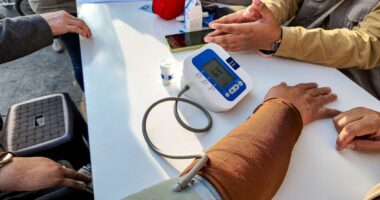Share this @internewscast.com

A pacemaker may be required when there is a problem with the ‘electrical conduction system’ of the heart. It may be inserted in the body to stimulate a faster heart rate when the heart is beating too slowly.
At the age of 76, celebrated Hollywood actor Arnold Schwarzenegger underwent a surgery to have a pacemaker implanted in his body. According to a People report, the former California governor revealed on his Arnold’s Pump Club podcast that he has been recovering from the procedure after having previously had three open-heart surgeries. “Last Monday, I had surgery to become a little bit more of a machine: I got a pacemaker. First of all, I want you to know I’m doing great! I had my surgery on Monday, and by Friday, I was already at a big environmental event with my friend and fellow fitness crusader Jane Fonda. Nobody would ever have thought I started the week with a surgery,” the Terminator actor was quoted as saying.
According to the report, Schwarzenegger had two surgeries in the year 1997 to replace his pulmonic valve and aortic valve; it would last 12 to 15 years. Later, he underwent surgeries to get both replaced in 2018 and 2020. The actor revealed that scar tissue from his last surgery caused him to have an irregular heartbeat that he was told to monitor. “I stayed in touch with my medical team and visited in-person at least once a year to get a full check-up and see how my heart was doing. That is life…with a genetic heart issue. But, you won’t hear me complaining,” he reportedly said.
What Is A Pacemaker?
According to the American Heart Association, a pacemaker is a small battery-operated device that helps the heart beat in a regular rhythm. Traditional pacemakers have three parts: a generator, wires (leads) and sensors (electrodes). Some newer pacemakers, however, are wireless. The device produces electrical impulses to help control abnormal heartbeats, and is usually implanted under the skin through a small incision on the chest under the collarbone or in the stomach area.
According to hopkinsmedicine.org, a doctor may recommend a pacemaker to ensure the heartbeat ‘does not slow to a dangerously low rate’.
When Is A Pacemaker Needed?
A pacemaker may be required when there is a problem with the ‘electrical conduction system’ of the heart. When the timing of the electrical stimulation of the heart to the heart muscle and the subsequent response of the heart’s pumping chambers is altered, the device may be used, states hopkinsmedicine.org.
What Happens When There Is A Problem With The Heart Rhythm?
As mentioned earlier, a pacemaker may be inserted in the body to stimulate a faster heart rate when the heart is beating too slowly. Hopkins Medicine explains that problems with the rhythm of the heart may cause difficulties in the body, because the heart is unable to pump an adequate amount of blood. In fact, if the heart rate is too slow, the blood is pumped slowly, and if it is too fast or too irregular, the chambers are ‘unable to fill up with enough blood to pump out with each beat’. As such, when the body does not receive enough blood, the following symptoms are seen:
- Fatigue
- Dizziness
- Fainting
- Chest pain
Examples Of Heart Rate And Rhythm Problems That Require Pacemaker:
Bradycardia: When the sinus node causes the heart to beat too slowly.
Tachy-brady syndrome: Characterised by alternating fast and slow heartbeats.
Heart block: When the electrical signal is delayed or blocked after leaving the sinoatrial (SA) node.
Schwarzenegger, who continues to be a fitness enthusiast till date, purportedly said on the podcast to urge people to get themselves checked: “I want you to know you are not alone. And if you’re putting something off out of fear, I hope I inspire you to listen to your doctors and take care of yourself.”












